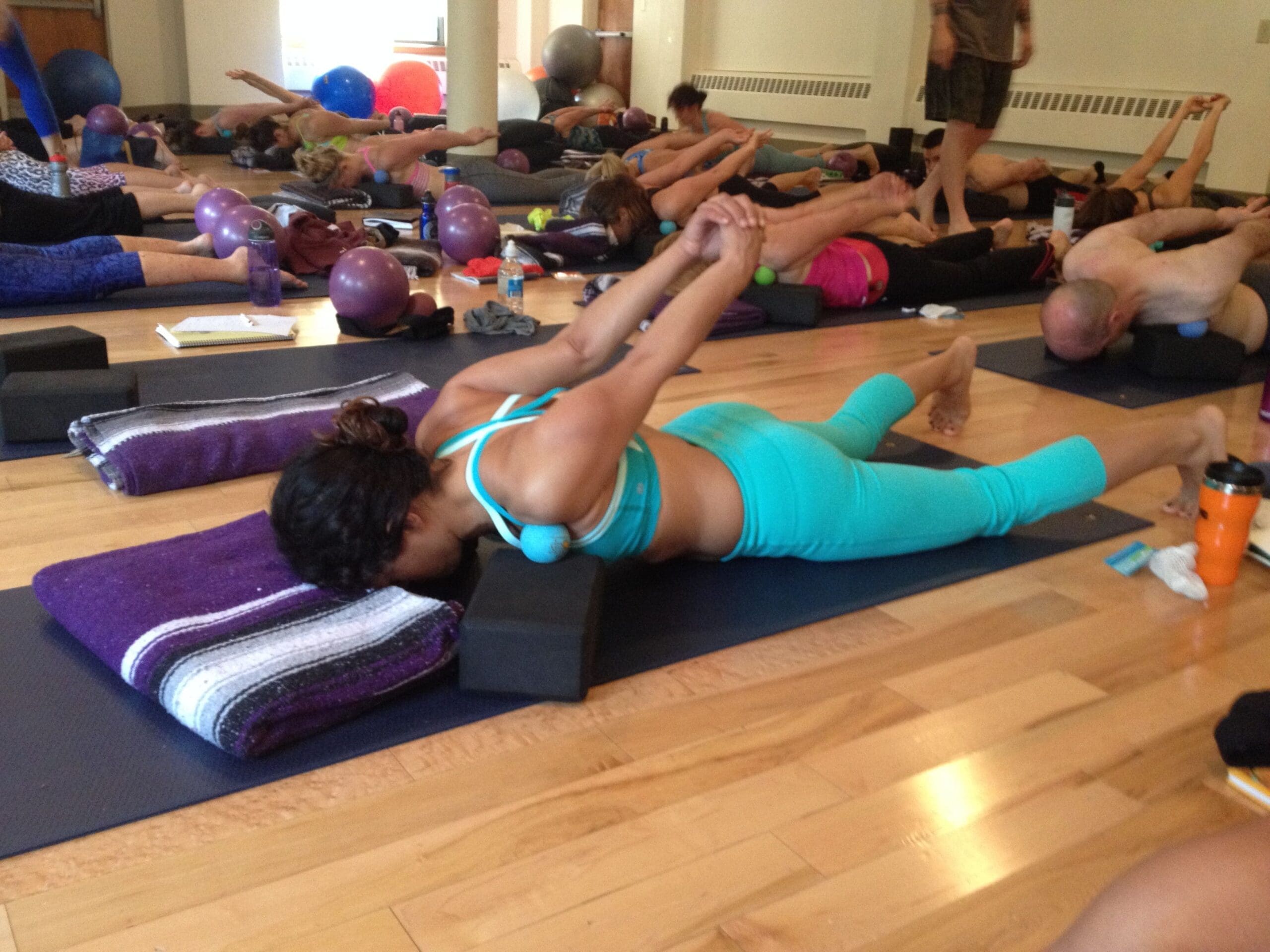
Earlier this year, Jill Miller led a Yoga Tune Up® teacher coaching call around the topic of YTU Flow. Several teachers spoke about their styles of teaching flow and guess what, each of us taught flow in a completely different way. This is no surprise given the commitment in the YTU community to thoughtful, creative teaching, no matter what your groove might be. It also underscores the fact that there is never one answer. I have written about YTU Flow in the context of your personal alignment to a yoga tradition, the community of yogis that you teach to (know your audience) and now I am closing the loop on a bigger idea: how to create a theme for your yoga teaching.
Let me reiterate: What makes a flow?
- Moving fluidly from one place to another.
- Intense focus and engagement in an activity.
- Rhythmic movement and breath coordination.
- A state of effortless concentration.
- One breath per movement.
- Breath x movement.
In my last blog, the discussion was about designing a class around DOMs, direction of movement in a joint. Now, let’s consider two more ideas that can spark a flow class: regressing and reorienting poses, both biggies in YTU.
Pose Regression
Let’s use Garudasana, eagle pose, as an example. First, get to know your pose. Study the anatomy. Learn the history. One of the benefits of this pose is that a colorful tale surrounds it. Garuda was the mythical bird who was the taxi (or Uber) of Lord Vishnu. He always knew where Vishnu was and/or needed to be and was sure to deliver. Have fun with the entertainment value of this story.
I love Garudanasana because it involves many elements (adduction, internal rotation, asymmetry, many joints plus a balance). Consider opening and closing this practice with a supine (lying on the back) garuda leg twist. This check/re-check creates context every time you introduce it and inevitably the twist is more potent each time you practice it during the class.
Seize the opportunity to add in appropriate rolling such as hips or glutes, upper back or pecs. Discover warm ups and cool downs that speak to actions of the pose. In YTU Level 1, we have been given regressions of eagle pose with garuda leg only positions in crunches and twists. Add in garuda arm only variations in Warrior II, III and/or humble warrior. After isolating the arms and legs of garuda, it is easy to put the pose together as the full version of garudasana.
Pose Reorientation
Reorientation requires you to come out of a literal world of poses and enter an approximate world. For example, if I am standing in mountain pose, tadasana, on my two feet how can I re-imagine it into another plane? How about horizontal in plank pose? Or horizontal on my back?
One of my favorite classes to teach is around the many Warrior III variations. Start on your back with a block under your sacrum. Add in a single leg apanasana (knees to chest). Advance to tubular core and corso leg lifts. Observe that you are now in Warrior III on your back. Continue to re-create this position every which way… through your vinyasas to the various Warriors, you might include deadlifts and Revolved Half Moon. As you move towards the close of the class, come back to the shape of Warrior III via the series.

Whatever format your classes take, never forget the rhythm of your breath. Breath and proprioception will serve your flow. So much of a flow yoga practice takes place between the poses. Chanel the breath first and then watch the movement unfold, literally inspired.
Be sure to see my last blog on YTU Flow: Teaching Yoga Tune Up®Flow Using Direction of Movement
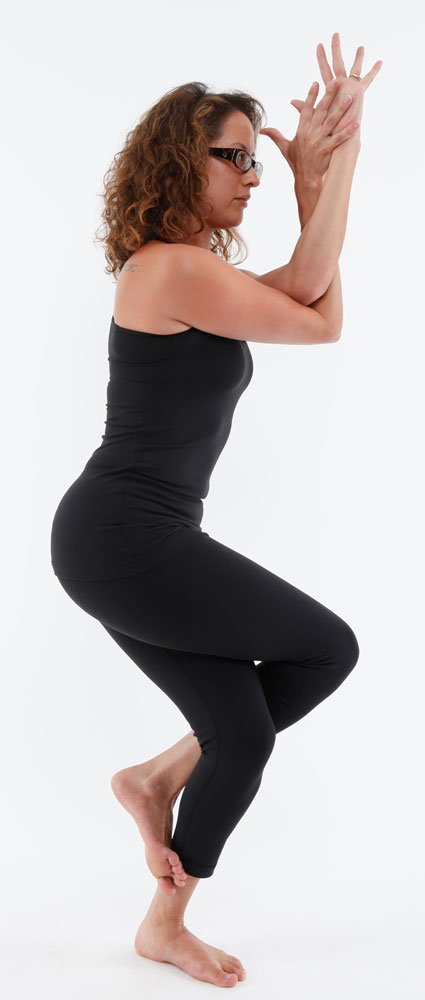



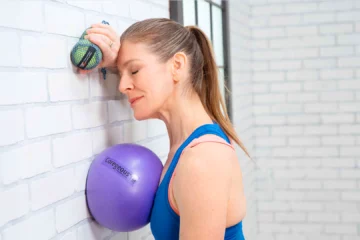
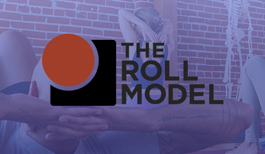



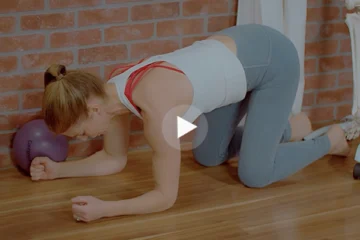
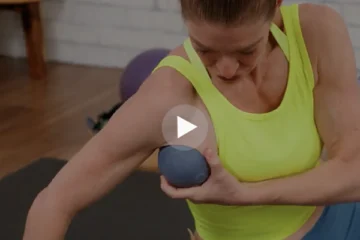


Thank you for this insightful blog post. I really like how you broke down Garudanasana and connected it to the story of the Garuda. It’s cool to think of the Garuda as Lord Vishnu’s loyal companion, always ready and aware of where he is and where he should be. I’m new to yoga, and Garudanasana feels almost impossible to me right now, but understanding the anatomy and the process of getting there makes it seem less intimidating. My personal wish is to one day feel like I have my own inner Garuda—strong and balanced—guiding me through my practice and my life.
Some of my FAVORITE classes are when the teacher weaves in myth & history of a pose during time dedicated for students to practice holding it ( to fill in the space I suppose ) Eagle is one of those funny contortionist poses that are so wobbley on your first/second/third try! I just love the practice of pose regression… it’s such a fun way to learn from a different POV! For me I am drawn rather to conclude an Eagle practice with an infinity supine posture to emphasize letting go of the internal rotation tension and ease into relaxation vs adding more/coming back to it. Is your suggestion to witness whether the internal rotation of the arms & legs becomes more accessible with practice of Garudasana or is it the contrast of the pose in standing (more effort) vs supine (less effort)?
I LOVE exploring all the possible orientations of a pose during a single practice! I’ve been incorporating it into my teaching for a few years now, so I’m stoked that it is actively encouraged in Yoga Tune Up! One of the things I really love about YTU is the endless possibilities to be as inventive and creative as you want – through the lens of building body and movement intelligence for our students.
Your ideas to put some flow in classes are very good. How to reorientate the pose or how to do many variations before doing the fully pose is very interesting. Thank you.
Yes! Some of my favorite ah ha moments of the Yoga TuneUp training were pose orientation practices.
Awesome, Nancy. Thanks for writing this. As a current student in the certification training, I am starting to think about how I will be including YTU poses and sequencing within my current modes of teaching, and this is helpful. I love the idea of using pose reorientation thematically in a class.
I really enjoy the reorientation of pose, but feel a bit of a struggle to let go & be creative… not my strong suit
Thank you for the detail here; although I have been teaching vinyasa with lots of sneaky strength peppered in for a while now and I am just taking my level 1 training in New York with Laurel Beversdorf,; learning soup to nuts how to create yoga tune up style classes. It has added so much to my tool box for creating challenging creative and inspiring classes. I also appreciate your definition of flow; I have a soft spot for Vinyasa flow for its breath centered movement and its very calming meditative qualities. I’m happy to see for myself that the yoga tune up poses can be easily placed within the context of a flow class.
I love these Eagle pose regression ideas! I will tuck these sequences into my back pocket.
Thank you for the detail here; although I have been teaching vinyasa with lots of sneaky strength peppered in for a while now and I am just taking my level 1 training in New York with Laurel Beversdorf,; learning soup to nuts how to create yoga tune up style classes. It has added so much to my tool box for creating challenging creative and inspiring classes. I also appreciate your definition of flow; I have a soft spot for Vinyasa flow for its breath centered movement and its very calming meditative qualities. I’m happy to see for myself that the yoga tune up poses can be easily placed within the context of a flow class.
I love these Eagle pose regression ideas! I will tuck these sequences into my back pocket.
I have been experimenting with pose reorientation and I find it has been so helpful in keeping my classes creative and interesting, not only to the students, but to me!
This is a great template for curating sequences with the YTU structure. Reorientation was a big AH HA moment for me in this training. Getting people in the pose in a more accessible way, to imprint the shape on the body so that when it is shifted and gravity demands more balance or strength in a different orientation, students have a way to create the mind-body connection and get into the pose easier.
Hi Nancy,
I love the idea of breaking down the pose into it’s components and check/re-checking how each piece impacts the final pose. Also, the history of the pose is a great idea and a wonderful way to tie into the lineage. Thanks!
This was a great series of blogs. I love the idea of researching the pose to give students a little backstory, helping them make a unique connection to the pose. I also thought the idea of breaking down the components of a pose, trying them separately would make them much more accessible to students. Changing the orientation of the pose was something I never really thought to do before taking the YTUTT. It has given me a whole new out look on what I can bring to my classes. Thank you!
It is amazing to see the pose orientation shaken up a bit. Playing with these variations is also an eye-opening experiment to see how these different movements are applied in every day life. By taking the pose out of context, it becomes easier to see the isolated movements strung together and pulled apart.
I’ve been teaching this way for a while now and not only do my students find value in reorientation, and many a-ha moments when we discuss DOMs and the actions of specific joints; but it has only enhanced my quality of teaching as well as making it EASIER. As a vinyasa teacher, it can be easy to caught up in the need to make each class new, exciting and full of variety. And, although that has its place, I feel we are missing so many opportunities to teach and encourage understanding and “mastery”. Thank you for relating this into the YTU arena.
I am currently taking the YTU level 1 training and so appreciate the “pose orientation” lessons. Our trainers are using flexible barbie dolls (23 joints!) to help illustrate how we can take the pose into different planes and variations. This also helped me to understand open and closed chains.
I’ve just finished Level 1 training and my mind is reeling with possibilities. This is super helpful to shift my thinking about putting classes together.
Thank you for this post. I’ve been struggling to figure out how to marry all my newly aquired knowledge and YTU level 1 poses into my vinyasa flow classes. I love the idea of considering flow as relevant to YTU by way of DOM and considering check- recheck and pose orientation into the progression of the flow.
“So much of a flow yoga practice takes place between the poses.” You said it! I think that’s where I have the most fun designing a sequence. The idea that the process is the pose is not only empowering as a teacher, but also for the students attending my classes.
Thanks for this really informative post about incorporating YTU into a vinyasa flow class. I love the idea of repitition and deconstructing the pose to put it all back together again!
I was really struck by your last sentence. I am reminded of this every once in a while. There is so much of yoga which happens between the poses when we are working with out breath and transitioning from place to place. Students tend to drop their attention as they head for a destination when there is so much to explore between poses.
Great article! I’m currently taking YTU Level 1 and will be teaching Garudasana. I’m happy to know the history of Garudasana and Lord Vishnu, and will definitely work that into my presentation.
Thank you Nancy. Your explanation of pose regression helps to deconstruct a yoga pose and use Yoga Tune Up poses to build my students up to it again.
I love the use of pose regression and pose reorientation to allow students (and myself) to feel the pose in different ways. One student might not “get” warior III while standing on one leg, but they might better understand if they try it on their back. Thanks for the post!
Thanks for the re-inspiration to get a little more creative in how I plan my classes!
Thanks for the re-inspiration to get a little more creative in the way I plan my classes!
Recently, I taught parvritti trikonasana (twisted triangle) in 3 different orientations. It really helped students focus on different elements of the pose and blind spots. The next time they flowed through it, they had a better grasp of all the elements and had a better understanding of how to piece it all together. Such a great learning technique.
I love eagle! Yes great tips on teaching it in a flow class with a little tune up involved! Thanks!
Am in the midst of Level 1 Training. We addressed this a lot! Love the article!
I see students struggle over and over to do eagle pose and taking a step back to prepare the body for eagle pose is a must. Doing things to facilitate better range of motion through the DOMS is tremendous!
Great article! I love the perspective of ways to breakdown, or regress garundasana and W3, and bridging that thought with the flow and breath of flow. Thanks!
I am so thankful for this blog. I am a new yoga teacher and 1 month after finishing I headed to my YTU training so I am still forming my style and what will work. I have taught several classes now with utilizing the YTU training but was feeling unsure of the flow. You gave some great ideas and I am already excited to get planning.
I love the concept of pose orientation. It sparks so much creativity as a teacher. It’s also great to know that if a student isn’t yet ready for Garudanasana, there are still many options available such as garuda leg only or arm only variations such as the ones you mentioned. I can’t wait to put these themed flows into practice!
Very upbeat blog post. I finished it and grabbed my notebook to start planning my next sequence.
I’ve found pose reorientation challenging. Thanks for taking us through some examples.
Thank you for this post, Nancy!
As a recent grad of Level 1, I’m beginning the process of introducing YTU into my existing classes. I love your suggestions around pose regression! It mirrors my own journey with beginner’s mind as I learn/unlearn/relearn inside of new/inspiring/challenging YTU poses. I’m finding such joy in my own exploration, that surely I can share that with my students through rewinding to the basics that sparked the interest to begin with 🙂
Thank you for the amazing blog and insight Nancy. The idea of introducing elements to your “peak pose” as early as the warm-up is very helpful. I also enjoyed the slight history lesson on Eagle Pose. What I felt most beneficial for my own practice was your mention of proprioception with a closed chained practice. We live in a show me society where we feel we must show what we can do (whether incorrectly or not) photogenically. What I like is the lack of flash with closed chained but the mass amount of benefits.
Thank you for the amazing blog and insight Nancy. The idea of introducing elements to your “peak pose” as early as the warm-up is very helpful. I also enjoyed the slight history lesson on Eagle Pose. What I felt most beneficial for my own practice was your mention of proprioception with a closed chained practice. We live in a show me society where we feel we have to show what we can do (whether incorrectly or not) photogenically. What I like is the lack of flash with closed chained but the mass amount of benefits.
Thank you, Nancy – for sharing the theme ideas for creating flow classes. I have been using pose regression towards a peak pose; now I can add DOM grids and pose reorientation into my repertoire. I believe that these techniques can even be nicely combined together in one class as the DOM grids will naturally lead to the regressions/preps for a peak pose.
As I enter the last half of my L1 YTU, this post is perfect for inspiring more creativity with the various ideas you share on theming a class. I really like the Warrior 3 on the block I had not thought of that one, I also really love your closing paragraph especially ‘ so much of a yoga practice takes place between the poses’ – so lovely. Thank you.
Thanks Nancy for sharing such valuable input towards creating a beautifully choreographed as well as sequenced YTU flow. This will definitely come in handy when I’m creating my first YTU seq using the context grids. I specifically love the last but not the least comment about the importance of breath and proprioception. x
I appreciate this article and find much resonance here as a Yoga Tune Up teacher AND a Vinyasa teacher. Much like you, Nancy, I find myself playing with various orientations and closed and open chain versions of the same postures as we flow in my Vinyasa classes and the more basic or easeful variations serve to prepare tissues and minds for the more challenging ones to come.
I also like how you defined flow and am wondering it a flow class in your opinion must meet all the criteria you listed or if one or if it is defined by meeting more criteria on your list I ask this because in my flow classes I give myself the liberty of not necessarily flowing one movement per breath but often cue an area of engagement or focus per inhale and another per exhale (for instance in Garudasana, I might say “Inhale, reach your elbows and finger tips up. Exhale, press your forearms forward. Inhale, expand the space between your shoulder blades. Exhale, tug your shoulder blades down and wide…).
Thank you for sharing practice and perspective!
I also teach a YTU flow type class, integrating strengthening and stretching postures I’ve learned through my YTU trainings, with a vinyasa style yoga. Your article gives me some additional insight to consider when designing my classes. I consider the peak pose (let’s say Camel or Cow-Faced pose) and add therapy ball rolling and YTU postures that will help my students experience the pose perhaps in a different way. My student enjoy the process and gain understanding into how a pose is broken down and how to warm up the parts of the body that are expressed in the pose. I need to listen to the coaching call you refer to and look forward to more discussion about YTU flow.
Pose regression and reorientation are both great ways to tailor a class for different type of students, especially there are different level of participants in one class. Also, start by rolling the involved muscles can set them up for success and definitely increase their interest in my class!
I’m in the middle of the Level I training now — thank you for your discussion of pose reorientation. I realize I’ve gotten too wrapped up in precisely recreating the same body position when maybe I can focus more on the essentials and be a little more open with matching the details. Thank you so much for this perspective!
Your writing is giving me so many ideas on how to create the sequences for my upcoming yoga classes. Thank you for the inspiration, thank you YTU training!
I am so grateful for this post! How to incorporate YTU into a flow class is a topic that continual comes up as I complete my YTU Level 1 Certification. I love and embrace YTU exactly how it is, but I worry that my students won’t be as open (at least not initially) to a different style, especially one that lacks the flow they are so accustomed to. Thank you so much for addressing this topic and for providing some building blocks and examples of how combine the two styles.
The first thing that struck me after reading the articled is “so much of a yoga practice takes place between the poses”. What a lovely and deep observation. I like the way Garudasana is broken down. Isolating hand and leg movements and then coming back to the pose seems to be a great and effective way of accomplishing the pose.